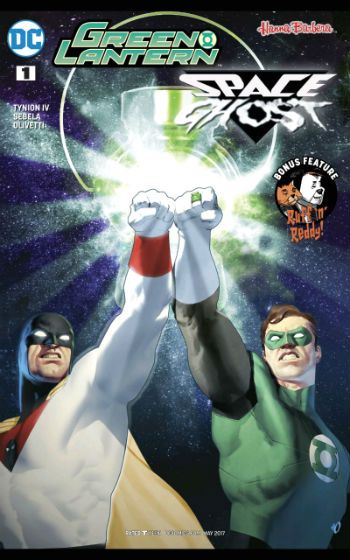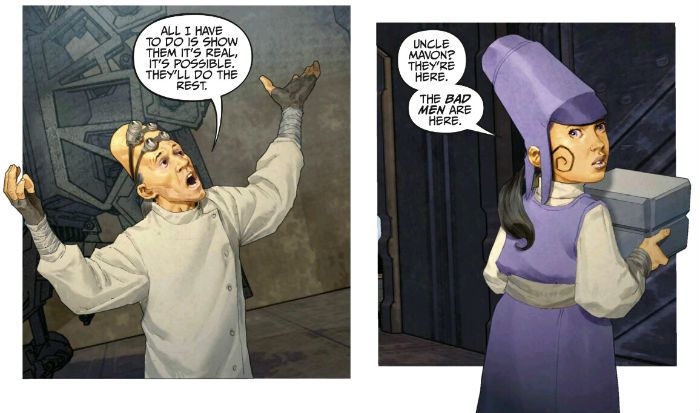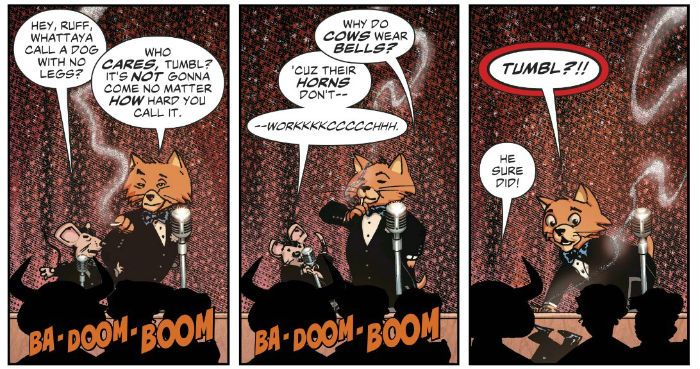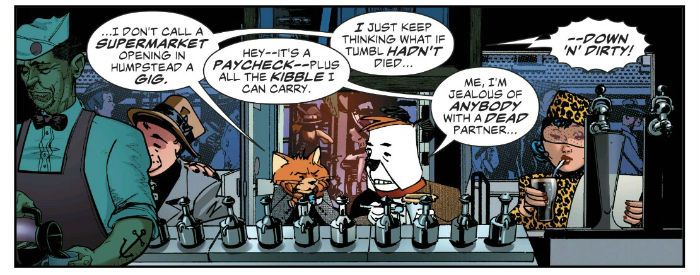“Lew's Gettin' Me BUPKIS." COMICS! Sometimes I Wonder Who Will Think Of The Children!
/
In which I talk about a kid’s comic featuring Space Ghost and Green Lantern. That’s right, I’m 47 years old. It’s called living the dream, baby. Living the dream! RUFF'N'REDDYby Chaykin, Quintana and Brosseau
GREEN LANTERN/SPACE GHOST SPECIAL #1 Art by Ariel Olivetti and Howard Victor Chaykin Written by James Tynion IV: The Voyage Home & Christopher Sebela, and Howard Victor Chaykin Lettered by A Larger Word Studios and Pat Brosseau Coloured by Ariel Olivetti and Wil Quintana Cover by Ariel Olivetti DC Comics, £2.99 (2017) Green Lantern created by John Broome, Gil Kane, Bill Finger, Martin Nodell & Gardner Fox Space Ghost created by Alex Toth, William Hanna & Joseph Barbera Ruff And Reddy created by William Hanna & Joseph Barbera

A Filthy Secret Revealed!

So, yeah, you probably noticed, despite all my efforts to convince you otherwise, I am old. So, no, I never know what those gifs or memes or what-have-yous are about; you know, those isolated 3 seconds of a movie ripped from their context and fixed in a loop things; what are they saying, what am I meant to be reading into this image of Lena Dunham making a “poopy” face? To be fair sometimes The Kidz do put big white capital letters on the moving image to help us eldsters along, but again stuff like, “POOPS BE POOPS, PEEPS!” leaves me less than enlightened. And Millennials? All I know about Millennials is everything is their fault. Or so I hear. From everyone who isn’t a Millennial. When I picture a Millennial in my head, as I often do, I see Keir Dullea in his bright white 2001:ASO space suit, maybe with the golden flare of knowledge beyond human reckoning where a normal human’s eyes would be. Or that weird Star Baby thing. I’m pretty sure neither of those is what a Millennial is, but I am pretty sure everything is still the Millennials’ fault. Because then it isn’t mine. So that’s okay. What I’m getting at is, I may not be the best person to judge this comic, which is, quite definitely a kids’ comic. Or at least the bit with Green Lantern and Space Ghost is a kids’ comic. We’ll get to the other bit later. If you are still awake. GREEN LANTERN/SPACE GHOSTby Olivetti, Tynion IV & Sebela and A Larger World Studios
George Orwell versus Hook Jaw! Kids’ comics! Unfortunately despite everyone thinking otherwise there’s no real consensus on what a kids’ comic should be. Having grown up imbibing the likes of Hook Jaw! and Flesh! via my eyes while still a child, I’m personally inclined to feel that the first thing a kids’ comic should be is unsuitable for kids. Opinions differ. I recently celebrated a milestone in my life: finishing the Everyman edition of George Orwell’s “Essays”. That’s no mean feat, it’s about 1350 pages long and it’s got no pictures neither, so, yay, me! The self-congratulation there being slightly undermined by the fact it t took me two years. Not because it was difficult, it isn’t (Orwell’s whole “thing” is accessibility) but it is worth savouring. I can be a bit of a greedy guts with books, but I’m glad I took the time with this one. George Orwell’s got it going on, basically. Ghandi, peat farming, Socialism being awesome, Communism being a) awful and b) not Socialism, honest book reviews, a running diary of WW2, pacifism dissected, the best schooldays memoir ever, and all (1940s) human life besides are in this book. Even comics! Yes, early on in the book (when I was younger) Orwell goes on about both boys’ and girls’ picture weeklies. In the ‘40s there was a very definite gender apartheid apparent in British children’s pictorial entertainment. I well recall this tendency lingering on well into the ‘70s, despite Pat Mills and John Wagner’s best efforts. The other major tendency Orwell identified included calcifying establishment values in the little tykes right from the off. Comics were very much don’t-rock-the–boat stuff. Orwell’s not really in favour of that, but then he’s certainly not in favour of the then emerging American comics:
“English children are still Americanised by way of the films, but it would no longer be generally claimed that American books are the best ones for children. Who, without misgivings, would bring up a child on the coloured "comics" in which sinister professors manufacture atomic bombs in underground laboratories while Superman whizzes through the clouds, the machine-gun bullets bouncing off his chest like peas, and platinum blondes are raped, or very nearly, by steel robots and fifty foot dinosaurs? It is a far cry from Superman to The Bible and the woodpile." "Riding Down From Bangor", p.1134 of "Essays" by George Orwell, Everyman's Library (2002)

I don’t often disagree with Orwell but, well, doesn’t that sound great? Except for the rapey stuff, obviously. Otherwise, I mean, that’s pretty much the appeal of American comics: their brash vulgarity and cheap sensationalism. Living in a grey backwater where the class system lingers like tenacious mould, as I do, that stuff sounds like the shit! And that was back in in the ‘40s! So, it’s a little odd to find in 2017 a comic quite so unthreateningly bland, as tediously insipid, as the Space Ghost/Green Lantern story here. It’s as though comics have gone backwards instead of forwards. No, sir, Shako died well, but he didn’t die for this! Not only do Space Ghost and Green Lantern mistake each other for enemies before joining forces to fight the real enemy (FRESH stuff!), but the real enemy here is Ignorance. I’ll give Tynion IV and Sebela points for not pretending that you can combat Ignorance by punching it or by making a giant green hat, but I’m not sure the whole thing about how Ignorance can be defeated by the power of Evidence is all that healthy either. What? Oh, GL and SG are both drawn to a mysterious sector of space cut off from the rest of the universe, in response to a distress signal claiming a new weapon exists capable of destroying everything(!). As it turns out it’s a space ship not a weapon, and it’s going to destroy everything by proving there’s a universe beyond the planet. Or something. It was all a bit muddled to be honest. But for some reason it’s a matter of some great importance that the people (who have big heads like aliens do in Green Lantern comics) on the planet believe there is only their planet. Anyway, identities are mistaken, blows exchanged, SG and GL use each other’s weapons and a small child is instrumental in defeating Ignorance. This is kind of benignly awesome as messages go, but kids are going to be pretty disillusioned once they get out into the real world. In the real world Evidence is super stuff, but people still tend to believe what they want. There are people in positions of power who don’t believe in dinosaurs, who think homosexuality is a “life style choice” (like ordering your books by colour instead of author), who honestly believe poor people didn’t try hard enough, and who believe Britain won WW2 single-handedly and so on and so forth. People in positions of power and people in your street. All Evidence to the contrary be damned. Some people don’t even believe that shelving your books by colour rather than alphabetising them is the act of an animal. And that doesn’t even need evidence, it’s just obvious! GREEN LANTERN/SPACE GHOSTby Olivetti, Tynion IV & Sebela and A Larger World Studios
A Sour Man Concludes

Basically, I doubt pointing at the universe and saying, “Look, we’re not alone!”, even if two garishly dressed hunks from other planets are stood next to you, would change the mind of an entire planet. Remember how the Apollo moon landing took place on a sound stage? Me neither. But someone thinks it did. Basically, this comic does nothing to prepare kids for a world where people still mistake Capricorn One (1978) for reality. Mind you, the comic’s not helped much by the art. Ariel Olivetti drops his beautifully rendered figures onto bland photoscapes, lending everything the lifeless air of an inept collage. The art seems to aspire to a timidity of visual imagination more suited to an automated process than something unique spawned by a mess of flesh and contradictory urges. Olivetti has almost managed to remove the humanity from his artwork, forgetting it’s his humanity that makes it art. The insipid visuals do fit the unchallenging narrative, so there’s that. Leave sterility to the operating room and couples counselling sessions and leave the wild creativity to the comics and the bedroom, is what I’m saying. To its credit this comic is well-intentioned, and its simplistic message is still better than telling kids that violence solves everything, but I think kids can take a bit of complexity. Essentially it underestimates kids, I think, which isn’t good in a kids’ comic. EH! GREEN LANTERN/SPACE GHOSTby Olivetti, Tynion IV & Sebela and A Larger World StudiosHoward Victor Chaykin’s Latest crime Against Eyes.
Space Ghost and Green Lantern take up most of the book but there’s a short bit at the back by Howard Victor Chaykin. Yes, that shy and retiring fellow, Howard Victor Chaykin. I don’t know if you caught it, but there was a bit of a kerfuffle recently about the cover to #4 of that HYSTERIA comic. I know you’ll be all agog for my defence of it but, alas, I thought it was a bit crappy. Draughtsmanship wise; art wise, that is. I got what it was “saying” but it took me some time to push past the awful drawing to the meaning, and I’m not sure the trip was worth it. I mean you need a surrounding that’s a lot more redolent of prosperous white Americana than some signage Ken “King” Bruzenak knocked up. It just looked like an enlarged panel instead of a proper cover, it also had that awful oh-I-can’t-be-farced-to-draw-everything-in-to-neaten-it-up-after-I’ve-blown-up-the-image feel that undermines a lot of Howard Victor Chaykin’s current panels. He can get away with it (just) in a panel but not on a cover. And that slur! It’s on a badge?!? Are these racist lynch mobs wandering around with little badges with racial slurs hand stitched onto them? “The needlework’s a bit lacking on this "P---", Terry. People are going to see this, you know. Try harder next time with the "N-----" ones. Tea, anyone?” If you’ve looked into the history of the 20th Century for more than 30 seconds you’ve probably seen photos of a lot of strung up bodies. Usually the defamatory nomenclature is written in blood across them (or shit? Some dark liquid, anyway), or on a bit of cardboard hastily tied round their neck, with shoelaces, string, whatever; this isn’t a how-to course. What I’m getting at is, in these mob slaughter scenarios very little thought seems to have been exerted on presentation skills (or indeed, basic decency). And do people still use "P---"? It was common parlance when I was a kid in the ‘70s. People, normal everyday people, would ask if you were going to the “P--- shop”?, like it was a shop that sold people whose racial origins could be traced back to a certain South Asian country considered to be the cradle of civilisation. Weirdly the “P--- shop” didn’t sell anything of the kind, and was largely a Newsagents or corner shop store owned by a family who probably knew less about Pakistan than the racist source of the question, despite their being brown. Apparently not all brown people are from Pakistan! The world is full of wonders! I don’t know, maybe people still use it. I’d hope not, but this week a Tory MP used the phrase “n----- in the woodpile”, so there you go; in Britain you’re never more than one word away from the 1970s. In essence I think Howard Victor Chaykin muffled the message of his cover with poor draughtsmanship. They’ve taken it down now, anyway. The cover of issue # 4 will now show your mom blowing a sailor. Probably.

RUFF'N'REDDYby Chaykin, Quintana and Brosseau
Ladies and Germs, Please Put Your Hands Together For…
In this part of the comic, a comic ostensibly aimed at children, Howard Victor Chaykin updates the animated duo Ruff’n’Reddy for a new Century. Yes! Ruff’n’Reddy! Who could ever forget Ruff’n’Reddy! Ruff! With his..er! And Reddy who was…um! But together they…eh! Thank fuck they’re back! Ruff and, er, Reddy! No, I’d never heard of them either. Largely because I may be old but I’m not very, very old. Ruff and Reddy (original title) was the first show (William)Hanna- (Joseph) Barbera Productions made for NBC following their being “let go” by MGM Studios in 1957. Because of the cost of theatrical animation MGM were cutting back on staff and relying on product already in the can. Having clearly learned a valuable lesson Hanna and Barbera hawked their Ruff and Reddy proposal to Screen Gems with the emphasis firmly on TV and budgetary efficiencies. It was cheap shit animation for the content starved TV market, someone ungracious might say. If you look it up on Wikipedia, like I obviously had to, the entry has a shameless emphasis on just how many corners Hanna and Barbera could cut and how little the show cost. This is the kind of thing people in Television get engorged over. Artistic schmartistic! How much is it gonna cost? Fuck television. (Except Twin Peaks, obviously). Actually it’s kind of neat, this emphasis on penny pinching since Howard Victor Chaykin’s modern art never met a corner it couldn’t cut. The side on street panels with a cast of characters milling about are a case in point. Howard Victor Chaykin uses the same background character models in each of these panels; so instead of it looking like a busy street scene your eye is irresistibly drawn to the repeated elements and it looks like instead they are trapped in some weird temporal anomaly, unable to escape the confines of the panel they are doomed to move about in for all eternity. It’s a spiritually apt approach for the revival of such an apparently cheap jack joint as Ruff and Reddy, I guess.

RUFF'N'REDDYby Chaykin, Quintana and Brosseau
I’m sure anyone who saw Ruff and Reddy has fond memories of it, because back then entertainment was limited to I Love Lucy, sock hops and burning crosses on lawns, so Ruff and Reddy was probably a nice change. Unlike the hostile relationship in Hanna and Barbera’s previous job, Tom and Jerry, Ruff and Reddy are housemates and pals. Oh, Ruff is smart and a cat, while Reddy is dumb and a dog. I guess hi-jinks ensue. It lasted three seasons, so suck on that Firefly fans. Cherubic Howard Victor Chaykin would have been about 8 years old when Ruff and Reddy originally aired (probably dressed in a stetson and fur fringed vest, with biscuit crumbs down his front) so maybe he has some fondness for the concept, if he has it hasn’t stopped him updating it. Here Ruff and Reddy are both comedians, working separately in other acts, or alone depending on circumstances. The short strip charts the eventful course of their less than stellar careers until they eventually team up and decide to take their show on the road. If this is intended for kids, I’m a Conservative Party member. Howard Victor Chaykin doesn’t just cast them as comedians he casts them as purveyors of risqué smut. It’s not quite blue, but it sure ain’t “My dog has no nose…” It’s the kind of double entendre larded humour peddled with a disingenuous wink by, I guess, Borscht Belt comedians: you know, your Mel brooks, your early Woody Allen, Ben Stiller’s dad and even, your Bernard Bresslaw(!). Borscht Belt comedians were named for the Jewish sour soup, Borscht, and traded in such stuff as, “A Jewish mother runs along the beach shouting, “Help, my son, the doctor, is drowning!” (Well, it makes me laugh.) Their routines emphasised neurosis and self-deprecation. Both of which are basically synonyms for intelligence. In another (better) universe Howard Victor Chaykin’s Ruff and Reddy would occupy a page each in Drew Friedman’s Old Jewish Comedians. The world Ruff and Reddy move through is a perpetual dusk of violent, venal and tawdry shenanigans; imagine Buddy Hackett and Don Rickles stumbling around Alexander MacKendrick’s Sweet Smell of Success (1957). Howard Chaykin throws in some good visual jokes (the “crickets” panel for example) and some venerable howlers as befits the acts, but the intentional seedy stink persists and cuts through the humour. The key scene is where Ruff and Reddy find common cause while beating the snot out of a couple of plagiarists in a back alley. It’s a down and dirty fight and the sight of blood spurting from comical animals in suits is discombobulating to say the least. In short, Howard Victor Chaykin’s Ruff and Reddy is totally unsuitable for kids; so they’ll probably love it. The little animals. GOOD!

RUFF'N'REDDYby Chaykin, Quintana and Brosseau
NEXT TIME: Who knows? Got a lot on my plate so we’ll see if I can move the metaphorical chips and beans around and make room for some – COMICS!!!











